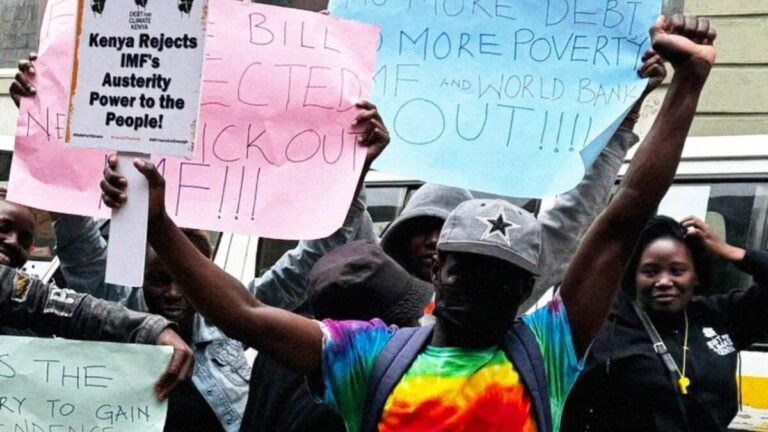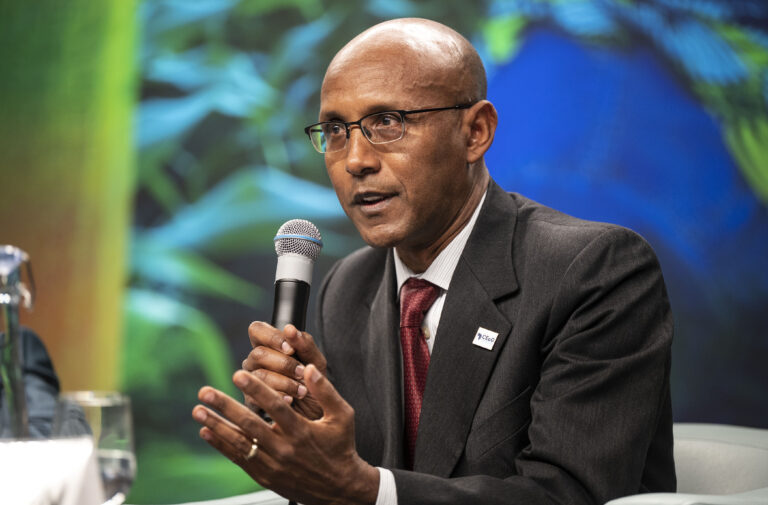
Residents of Kariobangi navigate along Huruma Road as rainwater mixed with raw sewage and garbage floods the area. (Photo/Francis Ndiretu).
By Daisy Okiring
Nairobi Kenya– At 6:30 a.m., the makeshift corridors of Pipeline estate are already awake with the sounds of children preparing for school, traders setting up their stalls, and the gurgling rush of wastewater through clogged, open trenches. But today, the air is different. A sharp stench rises from stagnant puddles that formed overnight after a short rainfall—a pungent mix of sewage, discarded food, and plastic. It is the smell of a city choking on its own growth.
“We are building houses on top of each other, but no one is building a drainage system,” says Kevin Maina, a 28-year-old boda boda rider in Pipeline. “When it rains, the garbage flows with the water, and the children swim in it.”
Across Nairobi’s most populated informal and underserved estates—Pipeline, Embakasi, Kibera, and Mathare—this story is repeated in different forms, but with the same ending: waste overflows, drains clog, roads flood, and lives are disrupted. The city’s rapid urbanisation, combined with decades of poor planning and weak enforcement, has created the perfect storm for an environmental disaster.
Overbuilt and Under-Serviced
Pipeline, one of Nairobi’s densest estates, was never planned to accommodate high-rise buildings. Yet today, it is a forest of ten-storey flats, separated by alleys barely wide enough for two people to pass. Most of these buildings are constructed without proper sewerage connections, garbage disposal points, or access roads. It’s not uncommon to find human waste in plastic bags—locally known as “flying toilets”—thrown into drainage ditches or behind buildings.
Also Read: Rwanda urged to embed agroecology and animal welfare
Just adjacent to Pipeline lies Embakasi, another expansive estate caught in the same trap. Once envisioned as a suburban refuge, Embakasi now wrestles with uncollected garbage that piles up at junctions, under bridges, and around markets. The open spaces that once served as community grounds have been swallowed by apartment blocks and illegal dumpsites.

With irregular garbage collection services, many residents resort to dumping waste outside their apartments—exposing themselves and their children to diseases. (Photo/Courtesy.)
“The city says not to dump, but they never collect,” says Mary Achieng’, a vegetable vendor in Tassia. “So people throw garbage in the drainage or burn it. Either way, it hurts us.”
The Crisis of Informality
Further west, the Kibera slum—Africa’s largest informal settlement—is a community defined by resilience, but also besieged by neglect. With more than 250,000 people living on just 2.5 square kilometres, Kibera has no formal waste collection system. Most households rely on communal toilets or makeshift pit latrines, which often overflow into alleyways and stormwater drains.

With no formal waste collection system, many in Kibera live amid garbage that clogs pathways and drainage systems, especially during the rainy season. (Photo/UN).
When it rains, much of Kibera turns into a muddy maze. Streams of black water snake between homes built from mud, iron sheets, and timber. The water carries with it everything—plastic, food waste, diapers, even animal remains. For many residents, this is simply routine.
“We grew up like this, and now our children are doing the same,” says Florence Atieno, a mother of four living in Laini Saba. “We can’t keep the house clean. Even if you sweep, the waste finds you.”
Nairobi’s Forgotten Valley
If Kibera is a city unto itself, Mathare is its overlooked twin. Built along the Mathare River, this densely packed settlement is home to more than 200,000 people. Here, the lack of drainage and waste management is complicated by the geography itself: many homes are built along steep slopes or next to the polluted river, making them especially vulnerable to flooding and landslides.
Also Read: Vanishing villages: The human cost of climate change in Baringo
During the March-April rains of 2024, over 3,000 families in Mathare lost their homes after floods swept through the lower valley. “The water came like a thief,” recalls James Kariuki, a 19-year-old student. “We were trying to scoop it out with buckets, but there was too much garbage. It blocked the drains and just pushed everything into our houses.”

The Mathare River is now more of a canal for waste than a waterway. It carries garbage from surrounding neighborhoods, dumpsites, and markets, emptying it downstream into Nairobi River. This pollution not only affects local residents but also contributes to the wider ecological degradation of the entire Nairobi River Basin.
Seeds of Hope
Amid the systemic failures, Nairobi’s youth continue to rise with innovative, community-based solutions. In Mathare, groups like Mathare Green Movement are reclaiming riverbanks, planting trees, and educating residents about environmental rights. In Kibera, youth are using digital tools to map waste hotspots and petition county authorities. In Pipeline, residents have started monthly clean-up drives—coordinated through WhatsApp groups—where households are assigned waste zones.

Youths in Mathare participate in a weekend cleanup drive organized by a local community group. (Photo/Courtesy).
Startups and social enterprises, such as Mr. Green Africa and TakaTaka Solutions, are also stepping in to professionalize recycling and incentivize households to separate waste. Yet without large-scale investment and policy backing, these efforts remain outmatched by the scale of the problem.
Nairobi at a Crossroads
Nairobi’s most popular estates are not just suffering—they are warning. If climate change is the fire, then poor planning and neglect are the fuel. As extreme weather events increase, informal and high-density estates will bear the brunt unless urgent structural changes are made.
It starts with acknowledging that these neighborhoods are not temporary. Millions call them home. They deserve clean streets, functioning drainage, garbage collection, and investment—not charity, but equity.
The children of Kibera, Mathare, Embakasi, and Pipeline are not waiting for miracles. They are navigating floods to get to school, building compost pits in alleyways, and creating art from waste. The least Nairobi can do is plan like it cares.




1 thought on “How waste and poor planning are suffocating Nairobi’s estates”
Comments are closed.